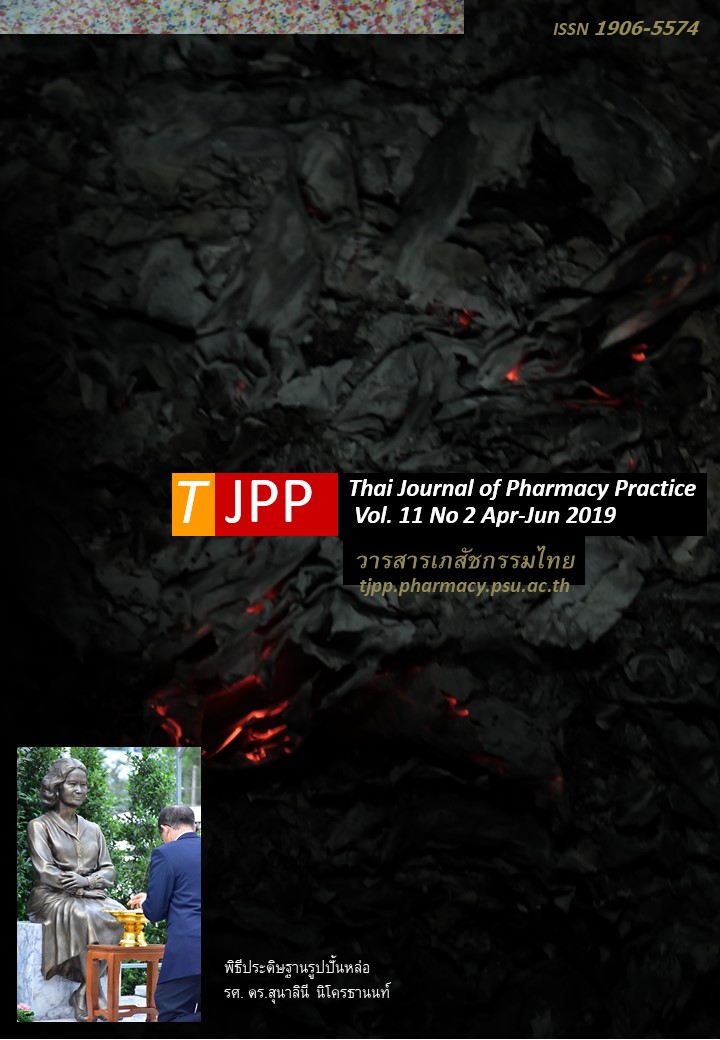การประเมินภาวะซึมเศร้าและความร่วมมือในการใช้ยาในผู้ป่วยโรคไตเรื้อรัง ในโรงพยาบาลชัยนาทนเรนทร
Main Article Content
บทคัดย่อ
วัตถุประสงค์: เพื่อประเมินภาวะซึมเศร้าและความร่วมมือในการใช้ยาในผู้ป่วยโรคไตเรื้อรังในโรงพยาบาลชัยนาทนเรนทร และเปรียบเทียบภาวะซึมเศร้าในผู้ป่วยที่ใช้วิธีการรักษาแตกต่างกัน รวมทั้งหาความสัมพันธ์ระหว่างความร่วมมือในการใช้ยาและปัจจัยส่วนบุคคลกับภาวะซึมเศร้าในผู้ป่วยกลุ่มนี้ วิธีการ: การวิจัยนี้เป็นการวิจัยเชิงพรรณนา ณ.จุดเวลาใดเวลาหนึ่ง กลุ่มตัวอย่าง คือ ผู้ป่วยโรคไตเรื้อรังที่เข้ารับบริการที่คลินิกโรคไตเรื้อรังแผนกผู้ป่วยนอกโรงพยาบาลชัยนาทนเรนทรจำนวน 316 คนโดยเลือกตัวอย่างแบบสะดวก การศึกษานี้ประเมินภาวะซึมเศร้าโดยใช้แบบสอบถาม Center for Epidemiologic Studies-Depression (CES-D) ฉบับภาษาไทย และวัดความร่วมมือในการใช้ยาโดยใช้แบบประเมินพฤติกรรมการใช้ยาในคนไทย หรือ Medication taking behavior measure for Thai patients (MTB-Thai) ผลการวิจัย: ผู้ป่วยร้อยละ 32.28 มีความเสี่ยงเป็นภาวะซึมเศร้า ผู้ป่วยที่ได้รับการรักษาโรคด้วยวิธีการที่ต่างกันมีภาวะซึมเศร้าไม่แตกต่างกัน ผู้ป่วยโรคไตเรื้อรังส่วนใหญ่ (ร้อยละ 65.51) ให้ความร่วมมือในการใช้ยาในระดับปานกลาง ผู้ที่ไม่ให้ความร่วมมือในการใช้ยามีความเสี่ยงต่อภาวะซึมเศร้ามากกว่า (P<0.001) คนโสดและผู้ที่หย่าร้างร้อยละ 54.17 และ 75.00 มีความเสี่ยงต่อภาวะซึมเศร้า ในขณะที่ผู้ที่มีคู่สมรสหรือหม้ายมีความเสี่ยงร้อยละ 29.49 และ 31.48 ตามลำดับ ข้าราชการและพนักงานรัฐวิสาหกิจ/เอกชนมีความเสี่ยงต่อภาวะซึมเศร้ามากกว่าอาชีพอื่น ส่วนปัจจัยส่วนบุคคลด้านอื่น ๆ ไม่มีความสัมพันธ์กับภาวะซึมเศร้า สรุป: ผู้ป่วยโรคไตเรื้อรังร้อยละ 32.28 มีความเสี่ยงต่อการเกิดภาวะซึมเศร้า ภาวะซึมเศร้ามีความเชื่อมโยงกับความร่วมมือในการใช้ยา และปัจจัยส่วนบุคคลบางตัว ได้แก่สถานภาพและอาชีพ
Article Details
ผลการวิจัยและความคิดเห็นที่ปรากฏในบทความถือเป็นความคิดเห็นและอยู่ในความรับผิดชอบของผู้นิพนธ์ มิใช่ความเห็นหรือความรับผิดชอบของกองบรรณาธิการ หรือคณะเภสัชศาสตร์ มหาวิทยาลัยสงขลานครินทร์ ทั้งนี้ไม่รวมความผิดพลาดอันเกิดจากการพิมพ์ บทความที่ได้รับการเผยแพร่โดยวารสารเภสัชกรรมไทยถือเป็นสิทธิ์ของวารสารฯ
เอกสารอ้างอิง
2. Liyanage T, Ninomiya T, Jha V, Neal B, Patrice HM, Okpechi I, et al. Worldwide access to treatment for end-stage kidney disease: a systematic review. Lancet 2015; 385: 1975-82.
3. Thanakiggaru P. Current Situation of chronic kidney disease in Thailand. Journal of the Department of Medical Services 2015; 40: 5-18.
4. Stanifer JW, Muiru A, Jafar TH, Patel UD. Chronic kidney disease in low-and middle-income countries. Nephrol Dial Transplant 2016; 31: 868-74.
5. Thomas B, Wolf S, Perico N, Cortinovis M, Courvill de Vaccaro K,et al. Maintenance dialysis throughout the world in years 1990 and 2010. J Am Soc Nephrol 2015; 26: 2621-33
6. Chuasuwan A, Praditpornsilpa K, editors. Thailand renal replacement therapy year 2013. Bangkok: The Nephrology Society of Thailand; 2013
7. Areekul M. Pharmacist counseling in hemodialysis patients at Pharmongkutklao and Rajvithi Hospital [master thesis]. Bangkok: Chulaongkorn University; 1999.
8. Kaplan B, Mason NA, Ascione FJ. Chronic hemodia lysis patients part I: characterization and drug- related problems. Ann Pharmcother 1994; 28: 316-19.
9. Grabe DW, Low L, Bailie GR, et al. Evaluation of drug-related problem in and out patients unit and the impact of a clinical pharmacist. Clin Nephol 1997; 47: 117-21
10. Manley HJ, Claran ML, Overbay DK, Wright MA, Reid GM, Bender WL, et al. Factors associated with medication-related problems in ambulatory hemodia lysis patients [online]. 2003 [cited Dec 25, 2016]. Available from: www.ncbi.nlm.nih.gov/
11. Palmer S, Vecchio M, Craig JC, Tonelli M, Johnson DW, Nicolucci A, et al. Prevalence of depression in chronic kidney disease: systematic review and meta-analysis of observational studies. Kidney Int 2013; 84: 179-91.
12. Varitsakul R, Sindhu S, Sriyuktasuth A, Viwatwong kasem C, Dennison Himmelfarb CR. The relation ships between clinical, socio-demographic and self-management: factors and complications in Thai peritoneal dialysis patients. Renal Society of Austral asia Journal 2013; 9: 85-92.
13. Artiwitchayanon A, Predictors of self-management in patients with chronic kidney disease undergoing continuous ambulatory peritoneal dialysis [master thesis]. Chonburi: Burapha University; 2015.
14. Sindhu S, Varitsakul R, Sriyuktasuth A. Factors associated with depression in elderly peritoneal dialysis patients. Journal of Nursing Science 2011; 29: 84 - 92.
15. Thokaew S. Depression in hemodialysis patients in Nakhon Pathom Province [master thesis]. Bangkok: Chulalongkorn University; 2003.
16. Bannasitrath R. Anxiety, depression, and psycho social factors in patients with chronic kidney disease in department of medicine, King Chulalongkorn Memorial Hospital [master thesis]. Bangkok: Chula longkorn University; 2009.
17. Larr S. Goldman, Nancy H. Nielsen, Hunter C. Champion. Awareness, diagnosis, and treatment of depression. J Gen Intern Med 1999; 14: 569-80.
18. Daniel C, Deborah S, Rahul M, Clinton D, and Paul L. Depression is an important contributor to low medication adherence in hemodialyzed patient and transplant recipients [online]. 2009 [cited Oct 10, 2017]. Available form: www.kidney-international.org.
19. Thokaew S. Depression in hemodialysis patients in Nakhon Pathom Province [master thesis]. Bangkok: Chulalongkorn University; 2003
20. Apivong D. Prevalence of depression in chronic kidney disease patients in Chulalongkorn Hospital. King Chulalongkorn Memorial Hospital [master thesis]. Bangkok: Chulalongkorn University; 2551
21. Chabunthom R. Effect of depression on medication adherence and glycemic control in patients with type 2 diabetes. King Chulalongkorn Memorial Hospital. [master thesis]. Bangkok: Chulalongkorn University; 2007.
22. Sakthong P, Sonsa-Ardjit N, Sukaarnjanaset P, Munpan W, Suksanga P. Development and psychometric testing of the medication taking behavior tool in Thai patients. (MTB-Thai). Int J Clin Pharm 2016; 38: 438- 45.
23. Weeradecha S. Predictors of self management in patients with chronic kidney disease undergoing continuous ambulatory peritoneal dialysis, Ramathi bodi Nursing Journal 2015; 21: 172-85.
24. Pongpoottipatchara R. Factors Influencing quality of life in pre-dialysis chronic kidney disease [master thesis]. Bangkok: Mahidol Univercity; 2012.
25. Roy C. The Roy adaptation model. 3 ed. Upper Saddle River New Jersey: Pearson Education; 2009.
26. Shokebumroong K. Care Models for patients with chronic renal failure [master thesis]. Bangkok: Chula longkorn University.
27. Fuch J, Schreirber M. Patient perception of CAPD and Hemodialysis stressors. ANNA Journal 1988; 15 : 282-86.
28. Pochanukul C. Treatment of kidney disease with hemodialysis for general practitioners. In: Pochanu kul C, editor. Kidney disease 2. Bangkok: Chulalong korn University; 1988.
29. Noree S, Bowolthumpiti A, Nochaiwong S, Koyratko son K, Chaisai C, Panyathong S. Prevalence and the correlation between depression and health related quality of life among hemodialysis and peritoneal dialysis patients. Songklanagarind Medical Journal 2017; 8: 301-12.
30. Grimm RH Jr, Svendsen KH, Kasiske B, Keane WF, Wahi MM. Proteinuria is a risk factor for mortality over 10 years of follow-up. MRFIT Research Group. Multiple Risk Factor Intervention Trial. Kidney Int Suppl. 1997 63: S10-4.
31. Lewis EJ, Hunsicker LG, Bain RP, and Rohde RD. The effect of angiotensin converting-enzyme inhibi tion on diabetic nephropathy. N Engl J Med 1993; 329:1456-62.
32. Gutch CF, Stoner MH, Corea AL. Review of hemo dialysis for nurses and dialysis personnel .6 th ed. St Louis: Mosby Year Book, 1999.
33. Vasrangsi V. Development of nursing guideline to meet psychosocial needs of the maintenance hemo dialysis patients [master thesis]. Bangkok: Mahidol
University; 1984.


